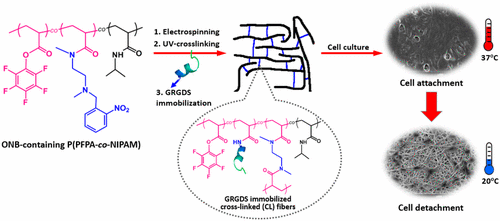当前位置:
X-MOL 学术
›
Biomacromolecules
›
论文详情
Our official English website, www.x-mol.net, welcomes your
feedback! (Note: you will need to create a separate account there.)
Thermoresponsive and Active Functional Fiber Mats for Cultured Cell Recovery
Biomacromolecules ( IF 5.5 ) Pub Date : 2017-10-09 00:00:00 , DOI: 10.1021/acs.biomac.7b00382 Wilaiporn Graisuwan , Songchan Puthong , Hui Zhao 1 , Suda Kiatkamjornwong , Patrick Theato 1 , Voravee P. Hoven
Biomacromolecules ( IF 5.5 ) Pub Date : 2017-10-09 00:00:00 , DOI: 10.1021/acs.biomac.7b00382 Wilaiporn Graisuwan , Songchan Puthong , Hui Zhao 1 , Suda Kiatkamjornwong , Patrick Theato 1 , Voravee P. Hoven
Affiliation

|
Thermoresponsive and active functional fiber mats were prepared from random copolymer of poly(pentafluorophenyl acrylate-co-N-isopropylacrylamide) (P(PFPA-co-NIPAM)), which was synthesized by a controlled radical polymerization process based on reversible addition–fragmentation chain transfer (RAFT). As reactive sites, pentafluorophenyl ester (PFP) groups were incorporated in the copolymer to allow for a multiple post-polymerization modification. UV-cross-linkable moieties were first introduced by partially reacting PFP groups in the copolymer with ortho-nitrobenzyl (ONB)-protected diamine. Electrospinning the resulting ONB-containing P(PFPA-co-NIPAM), followed by UV-induced cross-linking, yielded stable cross-linked thermoresponsive PNIPAM-based fiber mats. The remaining PFP active groups on the surface of copolymer fiber mats allowed for further conjugation with an H-Gly-Arg-Gly-Asp-Ser-OH (GRGDS) peptide, a well-known cell adhesive peptide sequence that was selected as a model in order to promote cell growth. At 37 °C, fibroblast cells were found to attach, spread, and proliferate well on the GRGDS-immobilized cross-linked (CL) fiber mat, as opposed to those on the GRGDS-immobilized un-cross-linked (UCL) fiber mat. By decreasing the temperature down to 20 °C, i.e. below the lower critical solution temperature (LCST) of thermoresponsive PNIPAM, cultured cells could easily be released from both GRGDS-immobilized CL and UCL fiber mats, whereas no cells were detached from tissue culture polystyrene (TCPS). These results suggest that the thermosensitive and active functional fiber mat obtained in this research represent an attractive and versatile platform for cultured cell recovery, which is beneficial for tissue engineering applications.
中文翻译:

具有热响应性和主动功能的纤维毡,可用于培养细胞的恢复
由聚五氟苯基丙烯酸酯-共-N-异丙基丙烯酰胺(P(PFPA-共-NIPAM))的无规共聚物制备热响应性和活性功能性纤维毡,该共聚物是基于可逆的加成-断裂链,通过受控的自由基聚合过程合成的转移(RAFT)。作为反应位点,将五氟苯基酯(PFP)基团掺入共聚物中,以进行多次聚合后修饰。首先通过使共聚物中的PFP基团与邻硝基硝基苄基(ONB)保护的二胺部分反应来引入可紫外线交联的部分。静电纺丝所得的含ONB的P(PFPA- co-NIPAM),然后进行UV诱导的交联,得到稳定的交联的基于PNIPAM的热响应性纤维毡。共聚物纤维毡表面上的剩余PFP活性基团可与H-Gly-Arg-Gly-Asp-Ser-OH(GRGDS)肽进一步偶联,GRGDS肽是众所周知的细胞粘附肽序列,被选作模型为了促进细胞生长。与固定在GRGDS的未交联(UCL)纤维垫上的细胞相反,在37°C时,发现成纤维细胞能在附着于GRGDS的交联(CL)纤维垫上良好地附着,扩散和增殖。 。通过将温度降低至20°C,即低于热响应性PNIPAM的较低临界溶液温度(LCST),可以轻松地从GRGDS固定的CL和UCL纤维垫上释放培养的细胞,而没有细胞从组织培养聚苯乙烯(TCPS)上脱落。这些结果表明,在这项研究中获得的热敏性和活性功能性纤维毡代表了培养细胞回收的有吸引力且用途广泛的平台,这对于组织工程应用是有益的。
更新日期:2017-10-09
中文翻译:

具有热响应性和主动功能的纤维毡,可用于培养细胞的恢复
由聚五氟苯基丙烯酸酯-共-N-异丙基丙烯酰胺(P(PFPA-共-NIPAM))的无规共聚物制备热响应性和活性功能性纤维毡,该共聚物是基于可逆的加成-断裂链,通过受控的自由基聚合过程合成的转移(RAFT)。作为反应位点,将五氟苯基酯(PFP)基团掺入共聚物中,以进行多次聚合后修饰。首先通过使共聚物中的PFP基团与邻硝基硝基苄基(ONB)保护的二胺部分反应来引入可紫外线交联的部分。静电纺丝所得的含ONB的P(PFPA- co-NIPAM),然后进行UV诱导的交联,得到稳定的交联的基于PNIPAM的热响应性纤维毡。共聚物纤维毡表面上的剩余PFP活性基团可与H-Gly-Arg-Gly-Asp-Ser-OH(GRGDS)肽进一步偶联,GRGDS肽是众所周知的细胞粘附肽序列,被选作模型为了促进细胞生长。与固定在GRGDS的未交联(UCL)纤维垫上的细胞相反,在37°C时,发现成纤维细胞能在附着于GRGDS的交联(CL)纤维垫上良好地附着,扩散和增殖。 。通过将温度降低至20°C,即低于热响应性PNIPAM的较低临界溶液温度(LCST),可以轻松地从GRGDS固定的CL和UCL纤维垫上释放培养的细胞,而没有细胞从组织培养聚苯乙烯(TCPS)上脱落。这些结果表明,在这项研究中获得的热敏性和活性功能性纤维毡代表了培养细胞回收的有吸引力且用途广泛的平台,这对于组织工程应用是有益的。











































 京公网安备 11010802027423号
京公网安备 11010802027423号